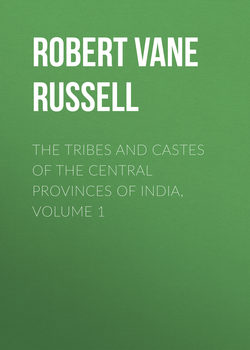Читать книгу The Tribes and Castes of the Central Provinces of India, Volume 1 - Robert Vane Russell - Страница 50
Part I.
Introductory Essay on Caste
Introductory Essay on Caste
47. Subcastes formed from social or religious differences, or from mixed descent
ОглавлениеSubcastes are also occasionally formed from differences of social practice which produce some slight gain or loss of status. Thus the Biyāhut or ‘Married’ Kalārs prohibit the remarriage of widows, saying that a woman is married once for all, and hence rank a little higher than the others. The Dosar Banias, on the other hand, are said to take their name from dūsra, second, because they allow a widow to marry a second time and are hence looked upon by the others as a second-class lot. The Khedāwāl Brāhmans are divided into the ‘outer’ and ‘inner’: the inner subdivision being said to exist of those who accepted presents from the Rāja of Kaira and remained in his town, while the outer refused the presents, quitted the town and dwelt outside. The latter rank a little higher than the former. The Suvarha Dhīmars keep pigs and the Gadhewāle donkeys, and are considered to partake of the impure nature of these animals. The Gobardhua Chamārs wash out and eat the undigested grain from the droppings of cattle on the threshing-floors. The Chungia group of the Satnāmi Chamārs are those who smoke the chongi or leaf-pipe, though smoking is prohibited to the Satnāmis. The Nāgle or ‘naked’ Khonds have only a negligible amount of clothing and are looked down upon by the others. The Makaria Kamārs eat monkeys and are similarly despised.
Subcastes are also formed from mixed descent. The Dauwa Ahīrs are held to be the offspring of Ahīr women who were employed as wet-nurses in the houses of Bundela Rājpūts and bore children to their masters. The Halbas and Rautias are divided into subcastes known as Puraīt or ‘pure,’ and Surāit or of ‘mixed’ descent. Many castes have a subcaste to which the progeny of illicit unions is relegated, such as the Dogle Kāyasths, and the Lahuri Sen subcaste of Barais, Banias and other castes. Illegitimate children in the Kasār (brass-worker) caste form a subcaste known as Tākle or ‘thrown out,’ Vidur or ‘illegitimate,’ or Laondi Bachcha, the issue of a kept wife. In Berār the Mahādeo Kolis, called after the Mahādeo or Pachmarhi hills, are divided into the Khas, or ‘pure,’ and the Akarāmāse or ‘mixed’; this latter word means gold or silver composed of eleven parts pure metal and one part alloy. Many subcastes of Bania have subcastes known as Bīsa or Dasa, that is ‘Twenty’ or ‘Ten’ groups, the former being of pure descent or twenty-carat, as it were, and the latter the offspring of remarried widows or other illicit unions. In the course of some generations such mixed groups frequently regain full status in the caste.
Subcastes are also formed from members of other castes who have taken to the occupation of the caste in question and become amalgamated with it; thus the Korchamārs are Koris (weavers) adopted into the Chamār (tanner) caste; Khatri Chhīpas are Khatris who have become dyers and printers; the small Dāngri caste has subcastes called Teli, Kalār and Kunbi, apparently consisting of members of those castes who have become Dāngris; the Bāman Darzis or tailors will not take food from any one except Brāhmans and may perhaps be derived from them, and the Kaith Darzis may be Kāyasths; and so on.
Occasionally subcastes may be formed from differences of religious belief or sectarian practice. In northern India even such leading Hindu castes as Rājpūts and Jāts have large Muhammadan branches, who as a rule do not intermarry with Hindus. The ordinary Hindu sects seldom, however, operate as a bar to marriage, Hinduism being tolerant of all forms of religious belief. Those Chamārs of Chhattīsgarh who have embraced the doctrines of the Satnāmi reforming sect form a separate endogamous subcaste, and sometimes the members of the Kabīrpanthi sect within a caste marry among themselves.
Statistics of the subcastes are not available, but their numbers are very extensive in proportion to the population, and even in the same subcaste the members living within a comparatively small local area often marry among themselves and attend exclusively at their own caste feasts, though in the case of educated and well-to-do Hindus the construction of railways has modified this rule and connections are kept up between distant groups of relatives. Clearly therefore differences of occupation or social status are not primarily responsible for the subcastes, because in the majority of cases no such differences really exist. I think the real reason for their multiplication was the necessity that the members of a subcaste should attend at the caste feasts on the occasion of marriages, deaths and readmission of offenders, these feasts being of the nature of a sacrificial or religious meal. The grounds for this view will be given subsequently.
